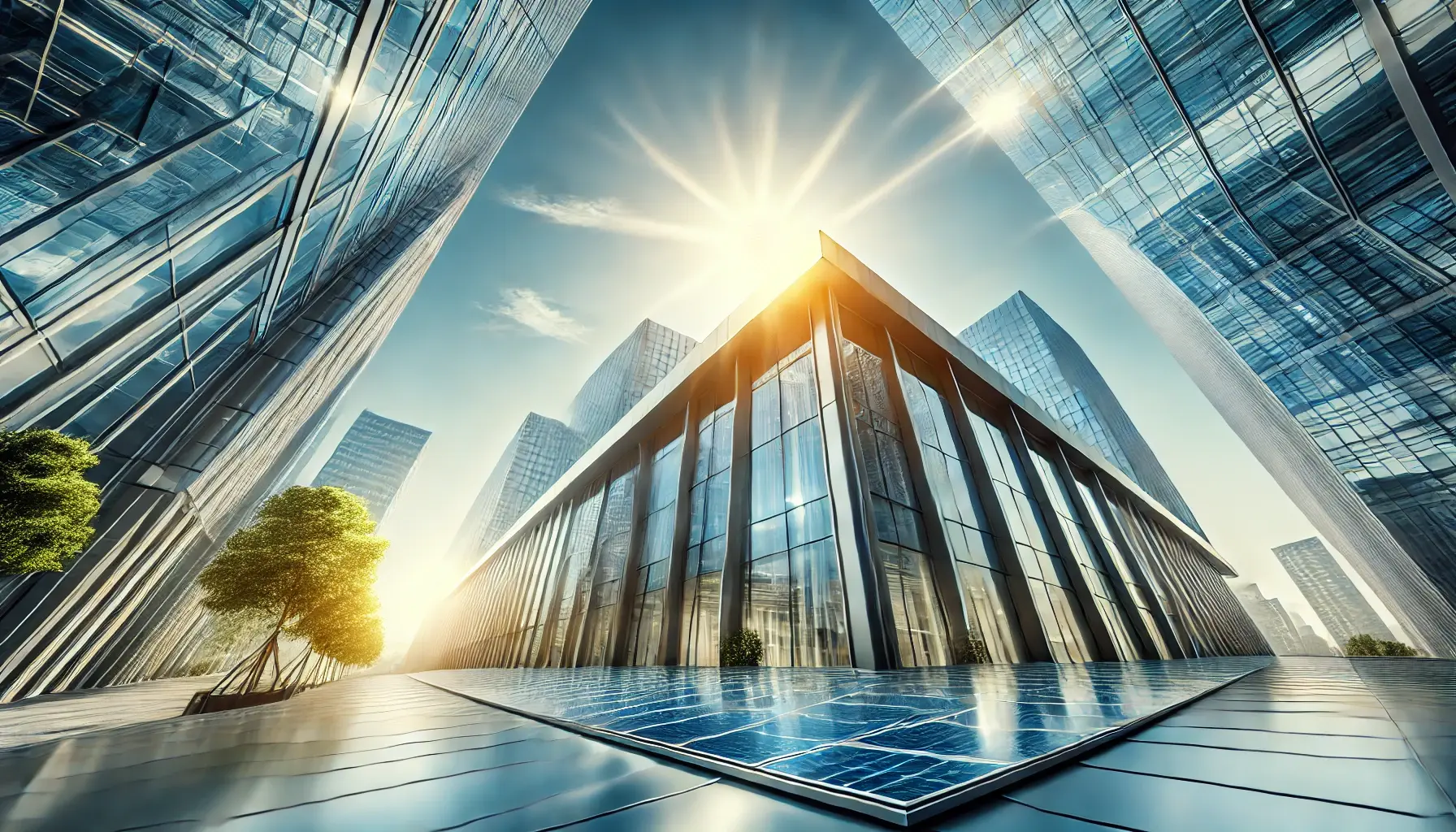Wichita summers are known for their intense heat, and keeping buildings cool during these hot months often leads to high energy bills. Air conditioning systems often work overtime, increasing utility costs for business owners. But what if there was a way to reduce these expenses while protecting your roof and keeping your building comfortable?
Reflective roof coatings offer an affordable, effective solution to this problem. These specialized coatings help lower energy costs, extend your roof’s lifespan, and contribute to a more sustainable future. In this article, we’ll explain what reflective roof coatings are, how they work, and why they’re an ideal choice for commercial buildings in Wichita.
Key Takeaways: The Role of Reflective Roof Coatings in Reducing Energy Costs in Wichita
- What Reflective Roof Coatings Are:
- Reflective roof coatings are materials applied to a roof’s surface to reflect sunlight and reduce heat absorption.
- They work well with various roofing types, including metal, single-ply membranes, and modified bitumen.
- How Reflective Roof Coatings Work:
- These coatings reflect sunlight (solar reflectance) and release absorbed heat (thermal emittance), keeping the roof cooler.
- A coated roof can be up to 50°F cooler than an untreated one, lowering indoor temperatures.
- Energy and Cost Savings:
- Reflective coatings can reduce cooling costs by up to 30%, making them an excellent investment for businesses.
- They also reduce strain on HVAC systems, extending their lifespan.
- Additional Benefits:
- Coatings protect roofs from UV damage and extreme weather, extending their lifespan.
- They help reduce your building’s carbon footprint and mitigate the urban heat island effect.
- Financial incentives like tax credits and utility rebates can offset installation costs.
- Ideal Applications:
- Reflective coatings are ideal for commercial buildings like warehouses, offices, and retail stores.
- Roofs in good condition and with significant sun exposure are the best candidates.
- Misconceptions Addressed:
- Reflective coatings don’t require a brand-new roof; they work well on existing roofs that are structurally sound.
- While they’re most effective in hot climates, they also protect roofs year-round, even in cooler weather.
- Why Choose Solid Rock Commercial Roofing:
- Solid Rock provides expert, personalized service, offering free consultations and energy audits.
- The company uses eco-friendly materials and offers strong warranties for peace of mind.
- Call to Action:
- Business owners in Wichita can lower their energy bills and protect their roofs by contacting Solid Rock Commercial Roofing for a free consultation and energy audit.
What Are Reflective Roof Coatings?
Reflective roof coatings are materials applied to the surface of a roof to reflect sunlight and reduce heat absorption. They’re made from specialized materials, such as acrylics, elastomerics, or silicones, which are designed to reflect the sun’s rays and release heat. This helps keep the roof cool and prevents heat from being transferred into the building.
When sunlight hits a standard roof, much of the heat is absorbed, raising the building’s interior temperature and increasing the need for air conditioning. Reflective coatings solve this problem by bouncing sunlight away from the roof and reducing indoor heat buildup. These coatings work well with various roofing types, including metal roofs, single-ply membranes, and modified bitumen.
How Reflective Roof Coatings Work
Reflective coatings are effective because of two key properties:
- Solar Reflectance: This measures how much sunlight the coating reflects. The higher the reflectance, the less heat the roof absorbs.
- Thermal Emittance: This measures how effectively the roof releases any heat it does absorb back into the atmosphere.
These two features work together to significantly reduce the temperature of the roof’s surface. For example, a roof treated with a reflective coating can be up to 50°F cooler than an untreated roof on a hot day, making a noticeable difference to the building’s overall temperature.
Benefits of Reflective Roof Coatings
Reflective roof coatings offer several advantages for business owners in Wichita, making them a worthwhile investment:
1. Lower Energy Bills
By reducing heat absorption, these coatings decrease the need for air conditioning, especially during peak summer months. Studies show that reflective roofs can cut cooling costs by up to 30%. For a mid-sized office building in Wichita, this could mean savings of thousands of dollars each year.
2. Longer Roof Lifespan
Heat and UV radiation cause wear and tear to roofs over time, leading to cracks, leaks, and costly repairs. Reflective coatings act as a protective barrier, extending your roof’s lifespan by reducing damage from the sun and extreme temperatures.
3. Environmentally Friendly
Lower energy use means your building has a smaller carbon footprint, contributing to a more sustainable community. Additionally, reflective coatings help combat the “urban heat island effect,” where city areas become hotter due to heat-absorbing surfaces like roofs and pavement.
4. Financial Incentives
Some reflective roof coating projects qualify for tax credits, utility rebates, or energy efficiency incentives, making them even more cost-effective. These programs can help offset installation costs and make the decision to upgrade even easier.
Reflective Coatings vs. Traditional Roof Solutions
When dealing with high energy bills, many business owners consider options like roof repairs or full replacements. While these can address structural issues, they don’t provide the same energy-saving benefits as reflective coatings.
Let’s consider two hypothetical businesses:
- Business A invests in reflective roof coatings.
- Business B chooses standard roof repairs.
After a year, Business A has reduced its energy bills by 25% and protected its roof from further damage, while Business B continues to face high cooling costs and ongoing wear and tear. Reflective coatings deliver a faster and more reliable return on investment compared to traditional roofing fixes.
Ideal Applications for Reflective Roof Coatings
Reflective coatings work well on many types of commercial buildings, including:
- Warehouses
- Retail stores
- Office spaces
If your roof is in good condition and gets plenty of sunlight, it’s an excellent candidate for reflective coatings. For the best results, apply coatings during mild weather in spring or fall to ensure proper curing. A professional roofing contractor can inspect your roof and confirm its compatibility with reflective coatings.
Addressing Common Questions About Reflective Roof Coatings
It’s natural to have questions about whether reflective coatings are right for your building. Here are answers to a few common ones:
- “Do I need a brand-new roof to use reflective coatings?”
No! Reflective coatings can be applied to most existing roofs as long as they’re in good condition and free of major damage. - “Will reflective coatings work in cooler climates?”
While they’re most effective in hot climates like Wichita’s, reflective coatings also protect roofs from wear and tear, reducing maintenance costs in any weather. - “Are coatings expensive to install?”
The upfront cost of reflective coatings is often lower than a roof replacement, and energy savings can help the investment pay off quickly.
Why Choose Solid Rock Commercial Roofing?
Solid Rock Commercial Roofing is Wichita’s trusted expert in reflective roof coatings. Here’s what sets us apart:
- Proven Expertise: With years of experience, we understand the specific needs of Wichita’s businesses and climate.
- Personalized Service: We provide free consultations and energy audits to ensure you get the best solution for your roof.
- Sustainable Practices: Our team uses eco-friendly materials to help you go green without compromising performance.
- Strong Warranties: Our warranties provide peace of mind, ensuring your investment is protected.
Conclusion
Reflective roof coatings are a simple yet powerful way to save on energy costs, extend your roof’s lifespan, and contribute to a more sustainable Wichita. By reducing heat absorption and protecting your roof from the elements, these coatings offer both immediate and long-term benefits for your business.
If you’re ready to lower your energy bills and protect your roof, Solid Rock Commercial Roofing is here to help. Contact us today for a free consultation and energy audit to get started. Start saving energy and protecting your roof today!
Frequently Asked Questions (FAQs): Reflective Roof Coatings and Energy Savings in Wichita
What are reflective roof coatings?
Reflective roof coatings are materials applied to the surface of a roof to reflect sunlight and reduce heat absorption. They help keep buildings cooler, lower energy costs, and protect roofs from wear and tear caused by UV rays and weathering.
How do reflective roof coatings save energy?
Reflective coatings work by:
- Reflecting sunlight to prevent heat buildup on the roof.
- Releasing absorbed heat back into the atmosphere.
This reduces the amount of heat entering the building, lowering the need for air conditioning and reducing energy bills by up to 30%.
Can reflective coatings be applied to any roof?
Reflective coatings work on many types of roofs, including metal, single-ply membranes, and modified bitumen. However, roofs must be in good condition with no major structural damage. A professional roofing inspection can confirm compatibility.
Do I need to replace my roof to use reflective coatings?
No, a roof replacement is not necessary. Reflective coatings can be applied to existing roofs as long as they are structurally sound and properly prepared before application.
Are reflective roof coatings only for hot climates like Wichita?
Reflective coatings are most effective in hot climates because they reduce heat absorption, but they also protect roofs from UV damage and weathering in all climates. This extends the roof’s lifespan and reduces maintenance costs year-round.
How much money can reflective roof coatings save me?
Savings vary depending on your building size and energy usage, but most businesses can save up to 30% on cooling costs. For a mid-sized commercial building, this could mean thousands of dollars in annual savings.
Are reflective roof coatings environmentally friendly?
Yes. By reducing energy consumption, these coatings help lower your building’s carbon footprint. They also contribute to reducing the urban heat island effect, making cities like Wichita cooler and more sustainable.
Are there any financial incentives for using reflective roof coatings?
Yes. Many reflective roof coating projects qualify for tax credits, utility rebates, or energy efficiency programs, helping offset installation costs.
When is the best time to apply reflective roof coatings?
Spring and fall are ideal seasons for applying reflective coatings. Mild weather during these times helps ensure the coatings cure properly and adhere well to the roof.
How long do reflective roof coatings last?
The lifespan of reflective coatings varies depending on the material and application, but high-quality coatings applied by professionals can last 10-15 years with proper maintenance.
How do I maintain a roof with reflective coatings?
Maintenance involves regular cleaning and inspections to ensure the coating remains intact. Addressing small issues early, such as cracks or peeling, can extend the life of the coating.
Why should I choose Solid Rock Commercial Roofing for reflective roof coatings?
Solid Rock Commercial Roofing is a trusted expert in Wichita, offering:
Eco-friendly materials and industry-leading warranties.
Free consultations and energy audits.
Experience with Wichita’s climate and roofing needs.
How do I get started with reflective roof coatings?
Contact Solid Rock Commercial Roofing for a free consultation and energy audit. Our team will evaluate your roof, discuss your options, and help you start saving energy and money today.
This article has been a collaboration between Rusty Cryer and OpenAI’s ChatGPT. Created on November 30, 2024, it combines AI-generated draft material with Cryer’s expert revision and oversight, ensuring accuracy and relevance while addressing any AI limitations.




